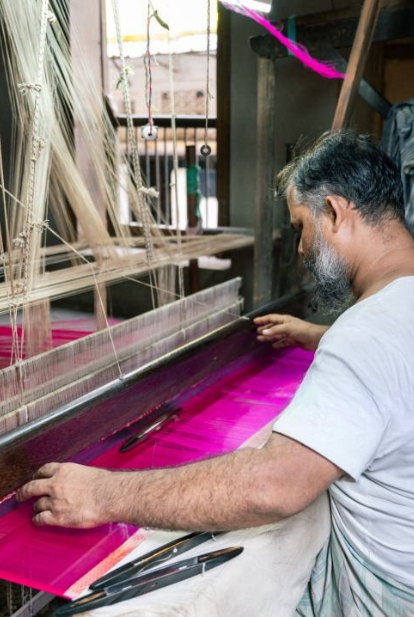Reading Time: 3 – 4 minutes
Table of Contents
1. When Every Thread Told a Story
2. Patola Silk (Gujarat) - The Dying Double Ikat
3. Toda Embroidery (Tamil Nadu) - The Tribal Canvas
4. Himbro (Hyderabad) - The Mughal Marvels
5. Kunabi Weave (Goa) - The Lost Tribal Check
6. Munga Silk (Assam) - The Golden Ghost.
When Every Thread Told a Story
In Mughal-era India, royal inventories listed over 400 distinct textile varieties. Today? Barely 40 survive commercially.
At village fairs a century ago, you'd find fabrics so fine they could pass through rings, so vivid they put rainbows to shame. These weren't just materials - they were living chronicles of our culture.
At Weavehand, we've made it our mission to rescue these disappearing arts before they become museum pieces. Here are India's most endangered weaves that deserve revival.
1. Patola Silk (Gujarat) - The Dying Double Ikat
What makes it special:
Each saree takes 6 months to make.
Both warp and weft threads are hand-dyed before weavin.
Only 3 families still practice authentic Patola weaving.
Why it faded:
Each saree takes 6 months to make.
Both warp and weft threads are hand-dyed before weavin.
Only 3 families still practice authentic Patola weaving.
Synthetic imitations flooded markets
Younger generations abandoning the craft
Weavehand's Revival: Working with surviving artisans to create contemporary Patola-inspired dupattas.
Synthetic imitations flooded markets
Younger generations abandoning the craft
What makes it special:
Geometric patterns telling tribal stories.
Done by Toda women on thick cotton.
Uses black and red threads made from local plants.
Current status: Less than 50 practitioners remain.
How to wear it today: As statement jackets or framed textile art.
3. Himroo (Hyderabad) - The Mughal Marvel
Historical significance:
Geometric patterns telling tribal stories.
Done by Toda women on thick cotton.
Uses black and red threads made from local plants.
Blend of silk and cotton invented for royalty.
Named after Persian "Hum-ruh" (similar).
Once used for royal tents and robes.
Blend of silk and cotton invented for royalty.
Named after Persian "Hum-ruh" (similar).
Once used for royal tents and robes.
Why you don't see it:
Requires 8 hours to weave just one meter.
Powerloom "Himroo" dupes dominate markets.
4. Kunbi Weave (Goa) - The Lost Tribal Check
Unique features:
Requires 8 hours to weave just one meter.
Powerloom "Himroo" dupes dominate markets.
Distinct red-and-black checks.
Worn by Goa's earliest tribal communities.
Woven on backstrap looms.
Distinct red-and-black checks.
Worn by Goa's earliest tribal communities.
Woven on backstrap looms.
Near extinction reason: Only 2 weavers still know the traditional technique.
Weavehand's project: Documenting the weave before it disappears completely.
5. Muga Silk (Assam) - The Golden Ghost
Fascinating facts:
Naturally golden silk from special worms.
Grows more lustrous with every wash.
Was British royalty's favorite in 1920s.
Naturally golden silk from special worms.
Grows more lustrous with every wash.
Was British royalty's favorite in 1920s.
Why These Weaves Matter
1. Cultural DNA: Each pattern encodes community histories.
2. Sustainable Wisdom: Ancient eco-friendly techniques.
3. Livelihoods: Every lost weave means families losing incomes.
How Weavehand is Fighting Back
Adopt-a-Weave program funding master artisans.
Modern interpretations of traditional patterns.
Direct marketplace for rare weaves.
Final Thought
These textiles survived wars and famines - only to fade in peacetime. But there's hope. When you choose authentic handloom, you're not just buying fabric - you're saving stories.
Be part of the revival: Explore Weavehand's collection of rare weaves at www.weavehand.com where every purchase preserve heritage.
Adopt-a-Weave program funding master artisans.
Modern interpretations of traditional patterns.
Direct marketplace for rare weaves.



